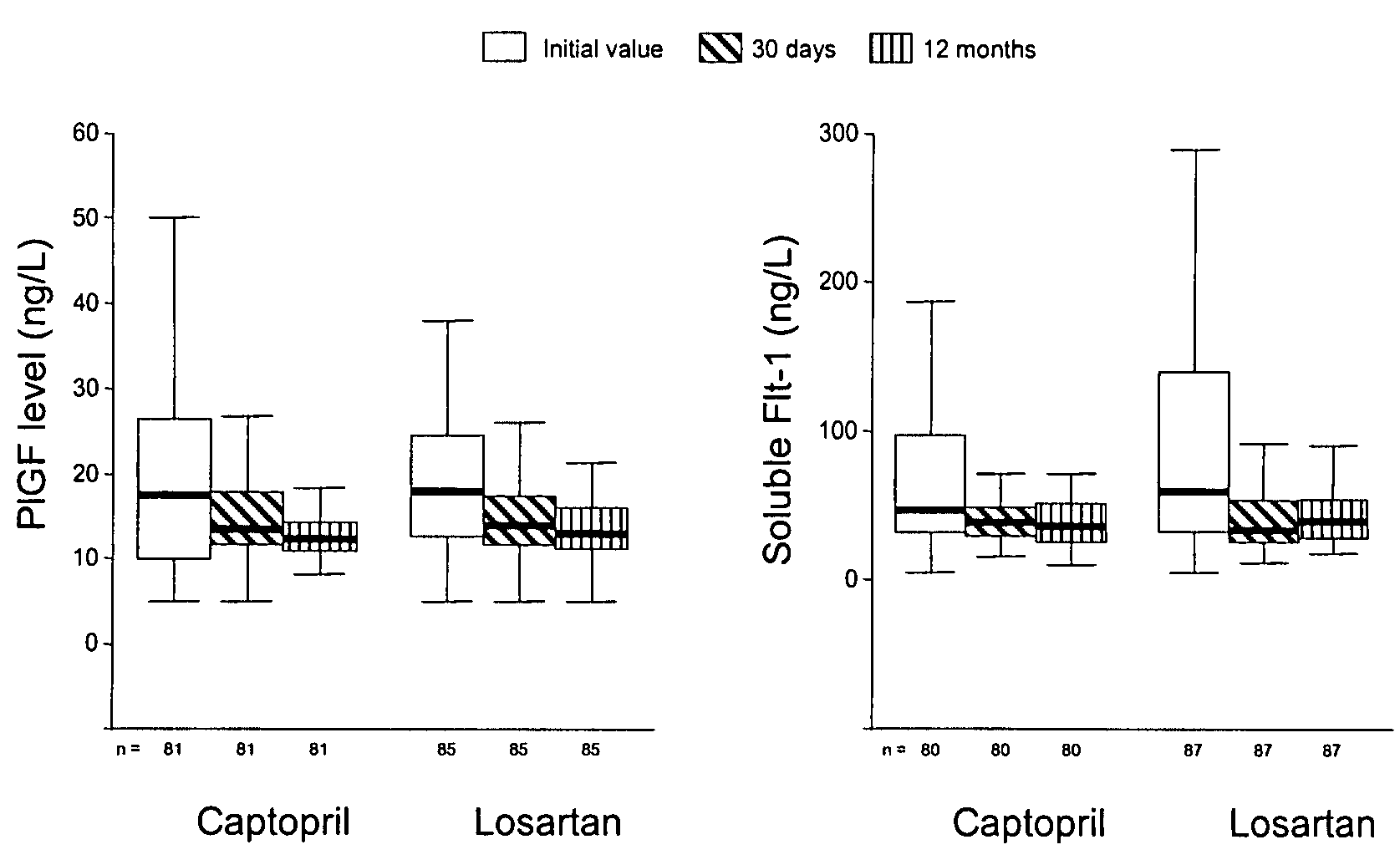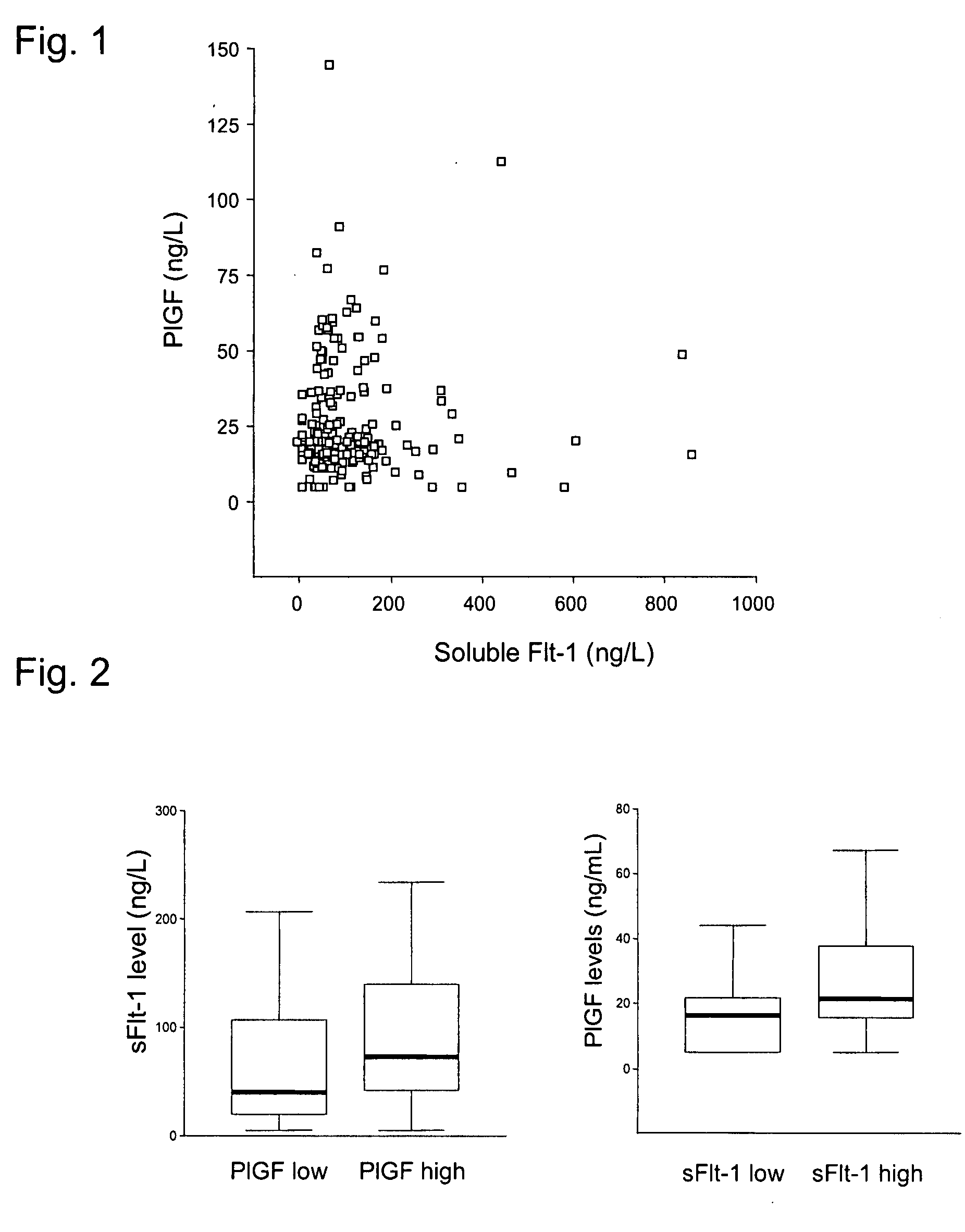PIGF and FLT-1 as Prognostic Parameters for Cardiovascular Diseases
a prognostic parameter and cardiovascular disease technology, applied in the direction of material testing goods, biochemistry apparatus and processes, instruments, etc., can solve the problem that the methods disclosed in the prior art are not transferable to vascular diseases with atherosclerotic etiology, and achieve the effect of reducing the risk of vascular disease and reducing the risk
- Summary
- Abstract
- Description
- Claims
- Application Information
AI Technical Summary
Benefits of technology
Problems solved by technology
Method used
Image
Examples
example 1
Relationship Between Vascular Events and the Plasma Concentrations of PlGF and sFlt-1
[0121]The patients were divided according to their median concentrations of biomarkers. The initial characteristics differed in patients with high PlGF concentrations and patients with low PlGF concentrations only with respect to the sFlt-1-concentrations (Table 1). In patients with elevated PlGF concentrations, the event-rates for the combined end points of mortality, non-fatal. myocardial infarction, stroke, and reuscitation resuscitation were significantly higher (38.8% vs. 18.3%; p=0.001) (FIG. 3) compared to those with low PlGF concentrations. With reference to the most important vascular events (death and non-fatal myocardial infarction), the differences persisted with an event rate of 30.4% in patients with elevated PlGF concentrations, compared to 15.7% in patients with low PlGF-concentrations (odds ratio 2.36 [95% CI 1.24-4.48]; p=0.012).
[0122]The initial characteristics differed in patient...
example 2
Interaction Between PlGF and sFlt-1
[0123]Patients with elevated PlGF concentrations also showed elevated concentrations of sFlt-1 (FIG. 2). Nevertheless, the sFlt-1 concentrations of both groups overlapped in a substantial range indicating that, surprisingly, the compensatory increase of the sFlt-1 concentrations in patients with elevated PlGF concentrations is inconsistent and can not be observed in all patients. Patients with PlGF concentrations in the two upper tertiles who, nevertheless, did not show an increase in the sFlt-1 concentrations (lower tertile), showed adverse after-effects compared to patients who exhibited sFlt concentrations in the uppermost tertile, but similarly elevated PlGF concentrations (FIG. 5). When the PlGF concentrations were only slightly elevated (second tertile), even a moderate increase in the sFlt-1 concentrations appeared to protect the patients from adverse after-effects. In contrast, in patients with strongly elevated concentrations of PlGF (thir...
example 3
Multivariable Regression Analysis
[0129]In order to further examine the potential prognostic independence of individual biomarkers, a stepwise multivariable logistic regression analysis was performed, comprising PlGF and sFlt-1, as well as further biochemical markers, such as BNP, a marker of neurohumoral activation, hsCRP, a classical acute phase protein, and sCD40L, a marker of thromboinflammatory activation. In addition, basic characteristics were taken into account that showed a significant prognostic meaning in an univariable model. For the combined end points after a four-year observation period, only two established risk factors, namely advanced age and diabetes, were found as independent prognostic parameters, after the biochemical markers were included in the model (Table 2). The markers BNP (p=0.043), sCD40L (p=0.007), PlGF (p=0.001), and sFlt-1 (p=0.006) remained important and independent prognostic parameters for the further disease progression, whereas hsCRP lost somewha...
PUM
| Property | Measurement | Unit |
|---|---|---|
| concentration | aaaaa | aaaaa |
| concentration | aaaaa | aaaaa |
| concentration | aaaaa | aaaaa |
Abstract
Description
Claims
Application Information
 Login to View More
Login to View More - R&D
- Intellectual Property
- Life Sciences
- Materials
- Tech Scout
- Unparalleled Data Quality
- Higher Quality Content
- 60% Fewer Hallucinations
Browse by: Latest US Patents, China's latest patents, Technical Efficacy Thesaurus, Application Domain, Technology Topic, Popular Technical Reports.
© 2025 PatSnap. All rights reserved.Legal|Privacy policy|Modern Slavery Act Transparency Statement|Sitemap|About US| Contact US: help@patsnap.com



